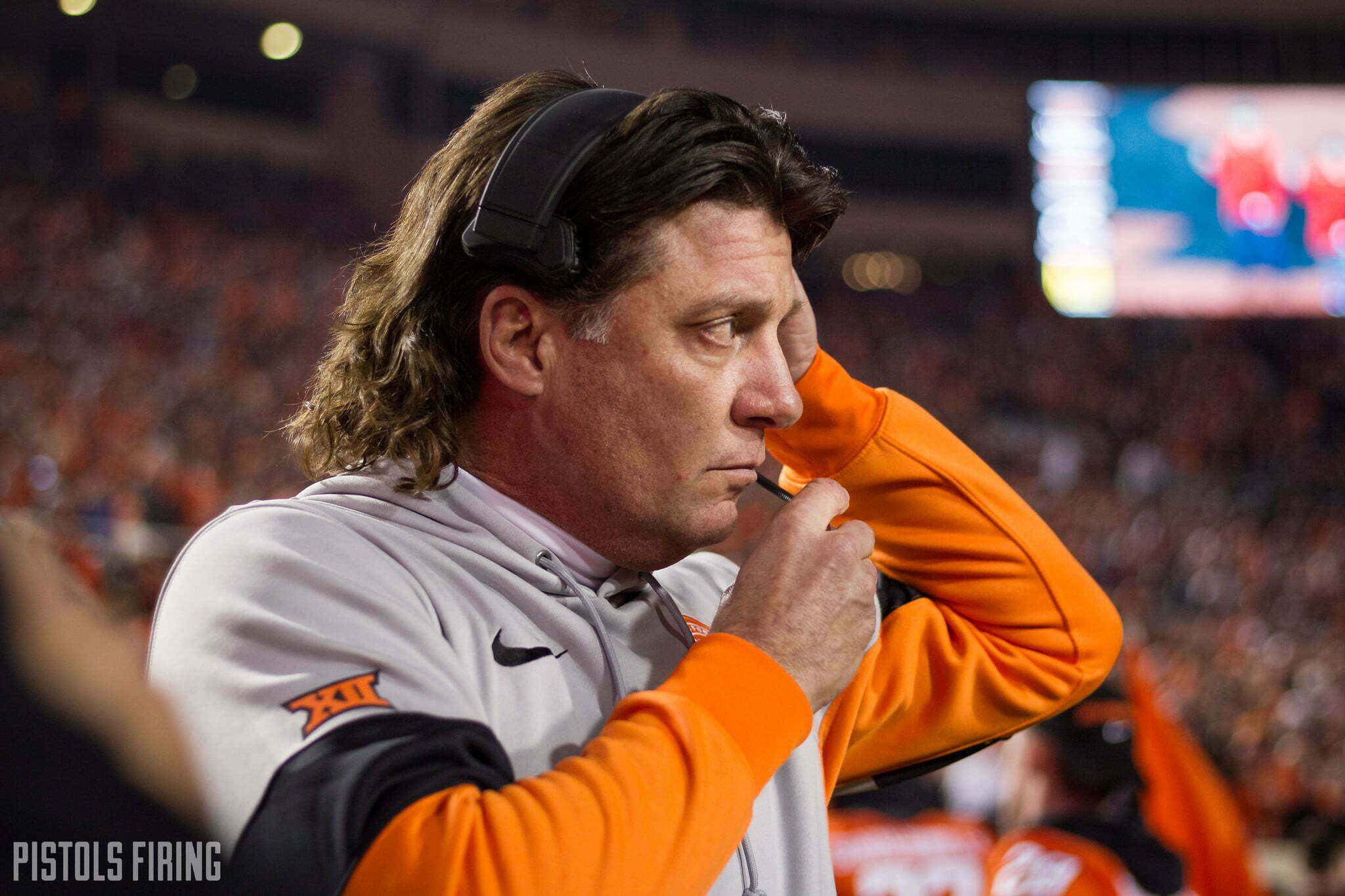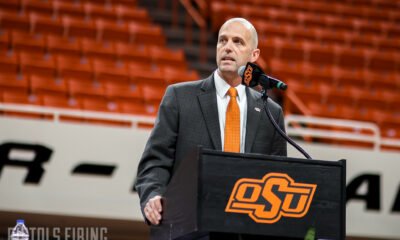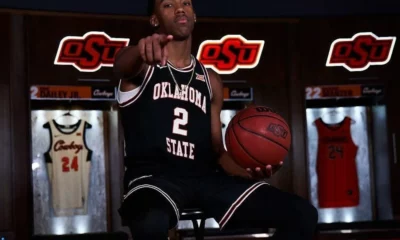Recruiting
Mike Gundy’s Recruiting Strategy: Three Stars Beat Waiting For Four Stars
How risk-averse are you?

This one drives us all nuts. Good players want to play for teams who win, therefore, you upgrade your roster when you show you can win with lesser players.
Sow wins, reap talented players.
So why doesn’t Gundy throw the kitchen sink at better recruits? Because he would say it’s a losing proposition for Oklahoma State football. These players will flirt and leave you at the altar. He has literally said that. Here’s the infamous quote.
“We win 10, 12 games, and we can get in on these [five-star] guys. We would get in a little bit, but we didn’t finish,” Gundy told ESPN. “So right, wrong or indifferent, we’ve gone right back to know your area, find out who’s out there, this is what we’re looking for to fit our system. Do they like to play football? Do they have respect for themselves, which gives them a chance to be successful? Do they fit what we’re looking for? Do we believe in them? If so, we’re going to go for them.”
Here’s the (maybe impossible) question I want to answer: What’s better for Oklahoma State — to lock in the generally less-talented three-star players or to wait on four- and five-stars and potentially fill in for misses with lower-end players after the three-star guys you could have gotten have departed?
Let’s answer this question in two ways.
1. What’s a reasonable expectation for the number of four-stars OSU could land?
To answer this, look at what teams most like Oklahoma State in other conferences have achieved over the last five years. Below are the teams with the amount of four-stars (and above) they signed per 247 in each class over the last five years.
| Team | 2019 | 2018 | 2017 | 2016 | 2015 | Average |
| Wisconsin | 3 | 1 | 2 | 3 | 1 | 2 |
| Purdue | 4 | 1 | 0 | 0 | 0 | 1 |
| NC State | 4 | 6 | 0 | 0 | 4 | 2.8 |
| Georgia Tech | 1 | 2 | 1 | 0 | 0 | 0.8 |
| Mississippi State | 6 | 5 | 4 | 3 | 7 | 5 |
| Arkansas | 11 | 2 | 4 | 6 | 7 | 6 |
| Texas Tech | 0 | 1 | 1 | 2 | 4 | 1.6 |
| Kansas State | 0 | 0 | 0 | 0 | 0 | 0 |
| Washington State | 0 | 2 | 1 | 0 | 1 | 0.8 |
| Arizona State | 5 | 2 | 4 | 5 | 6 | 4.4 |
| Oklahoma State | 3 | 2 | 2 | 1 | 2 | 2 |
The overall average? 2.4. Less than two-and-a-half four-star recruits end up going to the schools most like Oklahoma State. More than that go to SEC schools — most of Mississippi State and Arkansas’ four-stars were in-state gets.
Oklahoma State landing two per year is average (to slightly below average) for the non-blue blood, off-the-beaten-path schools generally finding some success. Bonus observation: Wisconsin’s Jonathan Taylor (yeah – the guy who won the Doak Walker over Chuba) was a three-star from New Jersey.
2. What overall strategy gets more talent on the roster?
This will involve a little math. Let’s look at a few different scenarios — one where Gundy goes for the gold by shunning the three-stars he’s been landing and crusading for the four-stars we would love to see (primarily linemen and all over the defense where we currently don’t see those) but that might leave him at the very end.
Using 247’s rating system I averaged the value of four-, three-, and two-star players (93.5, 84.5, and 74.5) and assumed that ten players could be in flux if you started pouring more resources into trying to get better players. That is, I assumed 15 of the 25 players would be Gundy’s three-star system guys. So let’s play the numbers and look at the scenarios.
I should note that this presumes that you’d have to backfill the missed four-star guys with lower-end three-stars or two-star players. This may or may not be the case, but it’s generally what Gundy was insinuating at the top in that quote.
| Going For It | **** | *** | ** | Talent Total |
|---|---|---|---|---|
| Wildly Successful | 7 | 1 | 2 | 88.8 |
| Moderately Successful | 5 | 2 | 3 | 86 |
| Whiffed | 1 | 5 | 4 | 81.4 |
| Laying Low | **** | *** | ** | Talent Total |
|---|---|---|---|---|
| Wildly Successful | 2 | 8 | 0 | 86.3 |
| Moderately Successful | 1 | 8 | 1 | 84.4 |
| Whiffed | 0 | 7 | 3 | 81.5 |
Above are estimates of the success levels for the various scenarios with “going for it” being the “Bring me all the Dez and Perish Coxs” and “laying low” being the current strategy — lock em’ in and sleep easy the night before signing day.
A couple of observations:
• OSU currently employs a “laying low” strategy with moderately successful returns. They sign a four-star quarterback, running back, or receiver and swim deep in the three-star pool with only one two-star recruit over the last five classes.
• The assumption is that if you wait until the final day for four-stars and they don’t commit, you’ll have to resort to some two-stars still available. Under the “Going For It” -> “Whiffed” scenario, your class would be 16 percent comprised of said players.
At the heart of all of this is the question: Is it better to get all of your three-stars in or better to have an unlikely chance that you land all of your horses and arm yourself in the football race?
What the numbers say is that there’s a negligible difference between being wildly successful at a conservative approach or moderately successful going for it. It really comes down to your natural risk preferences. Are you ok when injuries hit and a two-star has to play or the possibility with good health that these extra four-stars make for a serious run?
Think of it this way — would you rather be a Cowboy fan and know you’ll win eight games or be a Baylor fan (or an OU basketball fan) and miss a bowl every three years but go to Arlington one of those three years?
I’ve got an Arkansas buddy from church who’s so tired of wandering in the three-to-five win desert and he’d give his front tooth for eight wins every year. It really just depends on your preference but it’s pretty clear what Mike Gundy’s is: load up all the three-star lottery tickets you can get and be OK when they don’t pop and you wind up with decent depth.

-

 Football3 days ago
Football3 days agoFour-Star Quarterback Adam Schobel Commits to Oklahoma State, Flips from Baylor
-

 Hoops3 days ago
Hoops3 days ago‘Keep Turning Over the Rocks’: Looking at the Portal Landscape as Lutz Looks to Solidify His First OSU Roster
-

 Hoops3 days ago
Hoops3 days agoFour-Star Signee Jeremiah Johnson Reaffirms Commitment to Oklahoma State after Coaching Change
-

 Daily Bullets2 days ago
Daily Bullets2 days agoDaily Bullets (Apr. 23): Pokes Land Four-Star Quarterback, Retain Talent from Mike Boynton Era






